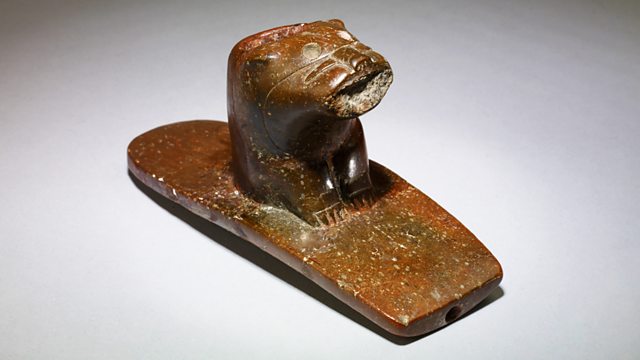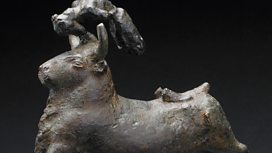North American otter pipe
The history of the world as explained through objects arrives in North America 2,000 years ago with a ritual stone pipe. How was it used and why was smoking so important?
The history of the world as explained through objects arrives in North America 2000 years ago and a stone pipe used in ritual. It is one of hundreds of pipes shaped as animals that were found in huge mounds in present day Ohio. Neil MacGregor pieces together the evidence for how these pipes were used. Tony Benn and the artist Maggie Hambling consider the allure of smoking from a modern perspective while Native American historian Gabrielle Tayac describes how the pipe formed a central role in traditional ritual and religious life.
Producer: Anthony Denselow
Last on
![]()
More programmes from A History of the World in 100 Objects about sport and entertainment
About this object
Location: Ohio, North America
Culture: Native North America
Period: 200 BC-AD 100
Material: Stone
��
The bowl for the tobacco in this pipe is in the top of the otter's head, and there is a small hole at one end to breathe in the smoke. The pipe was made by Native Americans living in what is today the US state of Ohio. These Native Americans were small-scale farmers who built large burial and ceremonial mounds. This pipe was buried with 200 other pipes in a collection of mounds known as the 'Mound City Group'.
What was the pipe used for?
This pipe was not simply smoked for pleasure but probably had a religious function. A shaman may have smoked it to evoke the otter as a representative of his clan, or as a spirit guide who would then accompany the shaman on a spiritual journey. Tobacco has been smoked in North America for at least 2300 years and pipe smoking still remains an integral part of modern Native American culture. Tobacco was first brought to Europe in the early 1500s, where it quickly spread across Europe, Africa and Asia.
Did you know?
- In historical accounts, the raw materials for pipes even included lobster claws and parts of gunstocks and gun barrels.
Rising smoke
By Devorah Romanek, curator, British Museum
��
This otter pipe has many stories to tell.
The two archaeologists who excavated it, Ephriam George Squire and Edwin Hamilton Davis, were the first to publish the scientific results of excavations in the US, in the Smithsonian Institution’s first volume in 1848, and the pipe and its excavation therefore can tell part of the story of early Americanist archaeology.
The pipe, also tells the story of the development of anthropology and contributed to the nineteenth century anthropological debate – it was said to represent a manatee, the design or pipe must have been imported from the Gulf of Mexico - an erroneous ‘fact’ used to question whether the sophisticated mounds from which this pipe comes could have been built by peoples related to present day Native Americans!
Most obviously this pipe tells the story of the mound building pre-European contact Americans, as traders and peoples who built elaborate tombs and ossuaries where these pipes were buried. Probably the pipe represented what today we might regard as a clan or familiar spirit, a helper in good times and bad.
The story I like best from this pipe, however, is the story of smoke. Smoke, for indigenous Americans, has the power to heal, is an offering, and consecrates. It is also thought today by some that just as smoke carries a message, thought or prayer to the skies or cosmos, conversely, the pipe bowl is a microcosm of the universe itself; and if one’s prayers are lifted to the skies, it is also so that one can hold smoke in the mouth to bring wisdom into the mouth before speaking.
This pipe, as a material manifestation of past practice conjures the ephemeral smoke that bound the smoker to his or her clan lineage spirits and, when the smoking was communal, bound people to one another, just as I feel bound to this pipe, through the intimacy of the form and the imaginings of smoke it invokes.��
A form of prayer
By Gabrielle Tayac, National Museum of the American Indian
��
It is a beautiful, beautiful pipe, and it makes you wonder who had it? Was it buried with somebody? Should we even be looking at it?
Understanding the concept that whoever it was who earned this pipe earned the right to carry that pipe and maybe it was buried with them and maybe it was something that was supposed to be with them in the other world, and maybe it’s not something for us. There are rituals and initiations that go along with it, tremendous responsibilities that go with being a pipe carrier. I hesitate to even call them objects.
Native people still use tobacco, it’s a very sacred item and it’s a form of prayer. The use of tobacco smoke is a way of transforming prayer and thought and community expression and putting it into a pipe.
When people were smoking what was called the “peace pipe” at a treaty negotiation – that is even more meaningful than to sign a document. It’s a way of sealing a deal not just legally but by giving a vow and confirming that to the wider universe. It’s really important to understand this idea of connection and relationship, it’s not just an individual act it’s a very collective act and a way of confirming and encoding and validating their prayers as being very serious.
Transcript
Broadcasts
- Tue 25 May 2010 09:4591�ȱ� Radio 4 FM
- Tue 25 May 2010 19:4591�ȱ� Radio 4
- Wed 26 May 2010 00:3091�ȱ� Radio 4
- Tue 8 Dec 2020 13:4591�ȱ� Radio 4
Featured in...
![]()
Sport and Entertainment—A History of the World in 100 Objects
A History of the World in 100 Objects - objects relating to sport and entertainment.
Podcast
-
![]()
A History of the World in 100 Objects
Director of the British Museum, Neil MacGregor, retells humanity's history through objects





